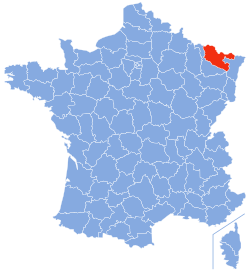You can help expand this article with text translated from the corresponding article in French. (December 2008) Click [show] for important translation instructions.
|
Moselle | |
|---|---|
 Prefecture building of the Moselle department, in Metz | |
 Location of Moselle in France | |
| Coordinates: 49°02′02″N 6°39′43″E / 49.03389°N 6.66194°E | |
| Country | France |
| Region | Grand Est |
| Treaty of Versailles | 28 June 1919 |
| Prefecture | Metz |
| Subprefectures | Forbach Sarrebourg Sarreguemines Thionville |
| Government | |
| • President of the Departmental Council | Patrick Weiten[1] (UDI) |
| Area | |
• Total | 6,216 km2 (2,400 sq mi) |
| Population (2021)[2] | |
• Total | 1,049,942 |
| • Rank | 23rd |
| • Density | 170/km2 (440/sq mi) |
| Time zone | UTC+1 (CET) |
| • Summer (DST) | UTC+2 (CEST) |
| Department number | 57 |
| Arrondissements | 5 |
| Cantons | 27 |
| Communes | 725 |
| ^1 French Land Register data, which exclude estuaries, and lakes, ponds, and glaciers larger than 1 km2 | |
| Part of a series on |
| Lorraine |
|---|
 |
Moselle (French pronunciation: [mɔzɛl] ) is the most populous department in Lorraine, in the northeast of France, and is named after the river Moselle, a tributary of the Rhine, which flows through the western part of the department. It had a population of 1,046,543 in 2019.[3] Inhabitants of the department are known as Mosellans.
- ^ "Répertoire national des élus: les conseillers départementaux". data.gouv.fr, Plateforme ouverte des données publiques françaises (in French). 4 May 2022.
- ^ "Téléchargement du fichier d'ensemble des populations légales en 2021" (in French). The National Institute of Statistics and Economic Studies. 28 December 2023.
- ^ Populations légales 2019: 57 Moselle, INSEE

